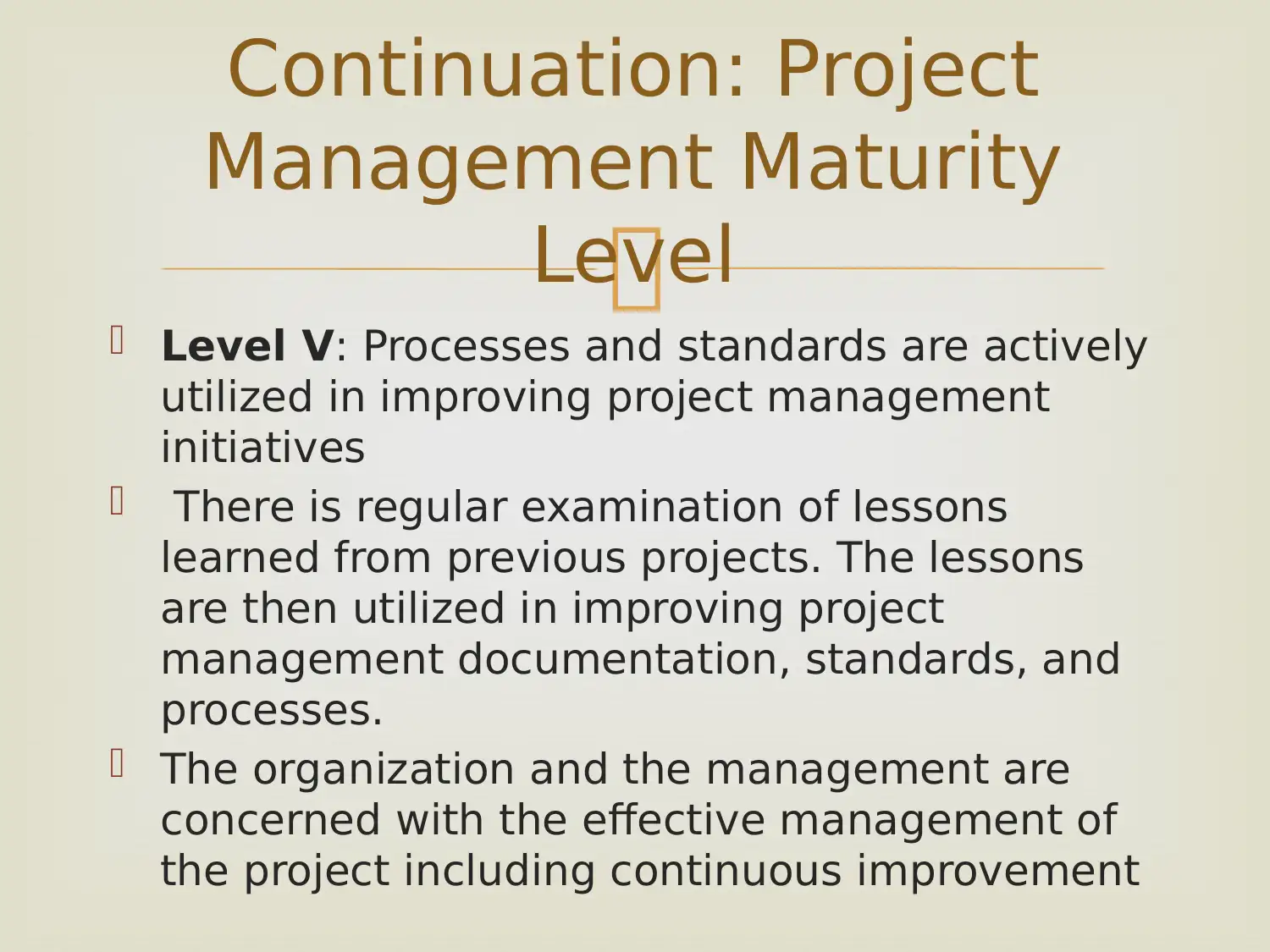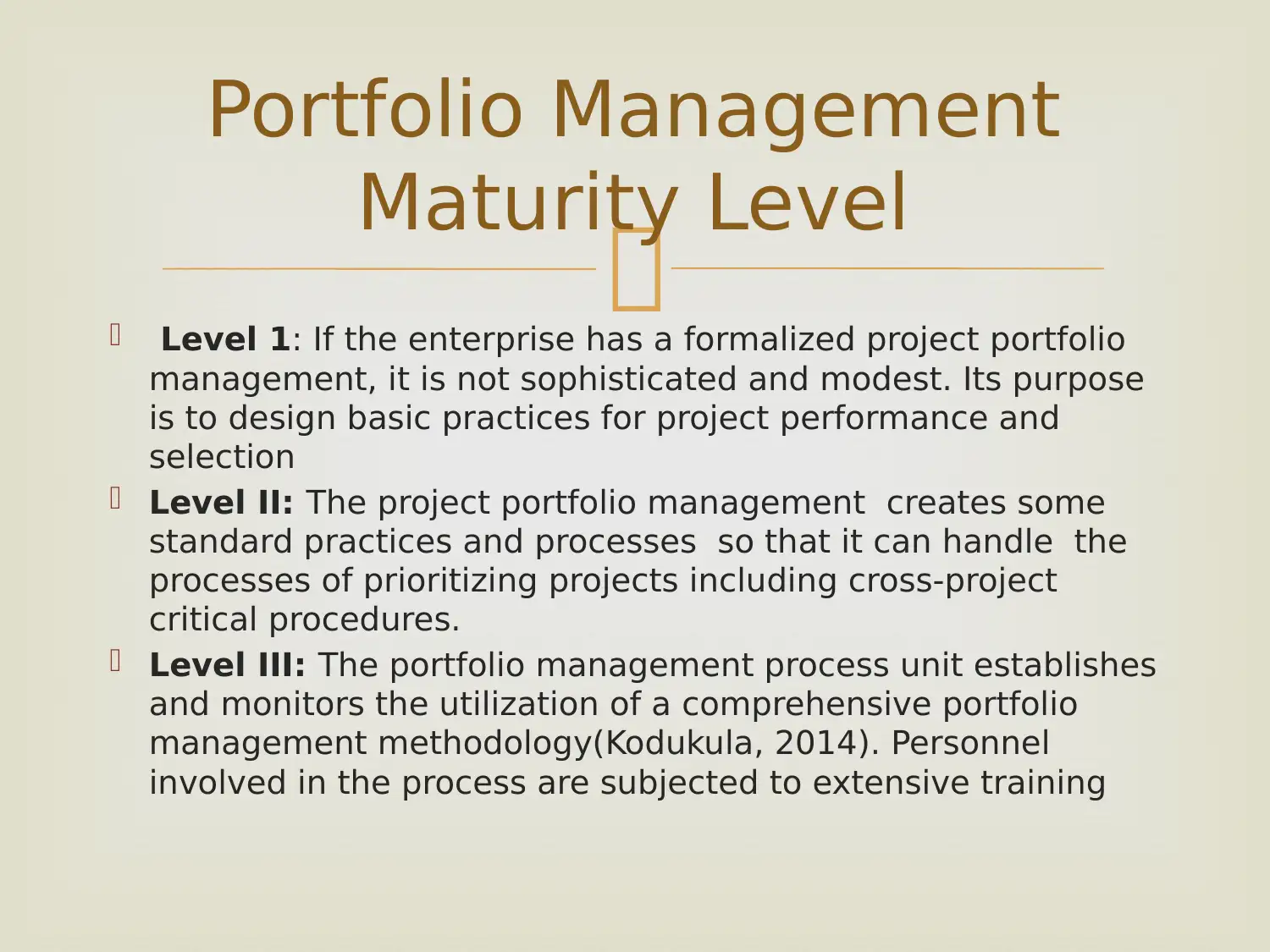Project vs. Portfolio Management Maturity Levels: A Comparison
VerifiedAdded on 2023/01/20
|10
|740
|1
Presentation
AI Summary
This presentation examines the differences between project and portfolio management maturity levels. It outlines the five levels within the maturity framework: process awareness, repeatable process, defined process, managed process, and optimized process. The presentation details the characteristics of each level for both project and portfolio management, highlighting how organizations evolve their processes. It covers the standards, practices, and metrics used at each level, emphasizing the transition from ad hoc methods to standardized, continuously improving processes. The conclusion stresses that higher maturity levels are characterized by more effective procedures, while lower levels reflect organizations that have less developed project management processes. References from Bivins, Kerzner, Kodukula, and Mullaly & Thomas are included.

Project vs Portfolio
Management Maturity
levels
Name:
Institutional Affiliation:
Project vs Portfolio
Management Maturity
levels
Name:
Institutional Affiliation:
Paraphrase This Document
Need a fresh take? Get an instant paraphrase of this document with our AI Paraphraser

Organizations are in pursuit of identifying
performance and competitive advantages
They then leverage these performance and
competitive advantages via enhanced delivery and
efficiency of services and products
For this reason, maturity models are increasingly
becoming crucial in assessing current capabilities
of an organization(Mullaly & Thomas, 2010)
They also help organizations in implementing
improvements and change in a structured manner
Introduction
Organizations are in pursuit of identifying
performance and competitive advantages
They then leverage these performance and
competitive advantages via enhanced delivery and
efficiency of services and products
For this reason, maturity models are increasingly
becoming crucial in assessing current capabilities
of an organization(Mullaly & Thomas, 2010)
They also help organizations in implementing
improvements and change in a structured manner
Introduction

The maturity framework is characterized by
five levels including:
Level I: Process awareness
Level II: Repeatable process
Level III: Defined process
Level IV: Managed process
Level V: Optimized process
Project vs. Portfolio
Management Maturity
Levels
The maturity framework is characterized by
five levels including:
Level I: Process awareness
Level II: Repeatable process
Level III: Defined process
Level IV: Managed process
Level V: Optimized process
Project vs. Portfolio
Management Maturity
Levels
⊘ This is a preview!⊘
Do you want full access?
Subscribe today to unlock all pages.

Trusted by 1+ million students worldwide

Level 1: Recognition of the existence of
project management processes. However,
there is absence of established standards or
practices and project managers are not held
responsible by any project standards.
Level II: The organization is characterized by
numerous project management processes.
However, they are not viewed as
organizational standards
Differences Between The Two
Maturity Models
Level 1: Recognition of the existence of
project management processes. However,
there is absence of established standards or
practices and project managers are not held
responsible by any project standards.
Level II: The organization is characterized by
numerous project management processes.
However, they are not viewed as
organizational standards
Differences Between The Two
Maturity Models
Paraphrase This Document
Need a fresh take? Get an instant paraphrase of this document with our AI Paraphraser

Level III: Project management processes designed
as organizational standards. The standards
consider internal customers and clients integral
and active part of the project team. Key project
issues, documentation and decisions are approved
by the management
Level IV: The management of a project is based
on its previous performance and what is expected
in the future. Effectiveness and efficiency metrics
are used to make decisions regarding the project
and how it affects other projects in the organization
Continuation: Project
Management Maturity Level
Level III: Project management processes designed
as organizational standards. The standards
consider internal customers and clients integral
and active part of the project team. Key project
issues, documentation and decisions are approved
by the management
Level IV: The management of a project is based
on its previous performance and what is expected
in the future. Effectiveness and efficiency metrics
are used to make decisions regarding the project
and how it affects other projects in the organization
Continuation: Project
Management Maturity Level

Level V: Processes and standards are actively
utilized in improving project management
initiatives
There is regular examination of lessons
learned from previous projects. The lessons
are then utilized in improving project
management documentation, standards, and
processes.
The organization and the management are
concerned with the effective management of
the project including continuous improvement
Continuation: Project
Management Maturity
Level
Level V: Processes and standards are actively
utilized in improving project management
initiatives
There is regular examination of lessons
learned from previous projects. The lessons
are then utilized in improving project
management documentation, standards, and
processes.
The organization and the management are
concerned with the effective management of
the project including continuous improvement
Continuation: Project
Management Maturity
Level
⊘ This is a preview!⊘
Do you want full access?
Subscribe today to unlock all pages.

Trusted by 1+ million students worldwide

Level 1: If the enterprise has a formalized project portfolio
management, it is not sophisticated and modest. Its purpose
is to design basic practices for project performance and
selection
Level II: The project portfolio management creates some
standard practices and processes so that it can handle the
processes of prioritizing projects including cross-project
critical procedures.
Level III: The portfolio management process unit establishes
and monitors the utilization of a comprehensive portfolio
management methodology(Kodukula, 2014). Personnel
involved in the process are subjected to extensive training
Portfolio Management
Maturity Level
Level 1: If the enterprise has a formalized project portfolio
management, it is not sophisticated and modest. Its purpose
is to design basic practices for project performance and
selection
Level II: The project portfolio management creates some
standard practices and processes so that it can handle the
processes of prioritizing projects including cross-project
critical procedures.
Level III: The portfolio management process unit establishes
and monitors the utilization of a comprehensive portfolio
management methodology(Kodukula, 2014). Personnel
involved in the process are subjected to extensive training
Portfolio Management
Maturity Level
Paraphrase This Document
Need a fresh take? Get an instant paraphrase of this document with our AI Paraphraser

Level IV: Portfolio project management unit
promotes the utilization of singular and
comprehensive portfolio management system in the
entire organization. There is full integration of
portfolio project management into the business
process
Level V: The portfolio project management
monitors the enterprise portfolio which is very
efficient(Bivins, 2011). It provides managers with an
opportunity to highlight continuous improvements
in procedures, processes, indices and models
Continuation: Portfolio
Management Maturity
Level
Level IV: Portfolio project management unit
promotes the utilization of singular and
comprehensive portfolio management system in the
entire organization. There is full integration of
portfolio project management into the business
process
Level V: The portfolio project management
monitors the enterprise portfolio which is very
efficient(Bivins, 2011). It provides managers with an
opportunity to highlight continuous improvements
in procedures, processes, indices and models
Continuation: Portfolio
Management Maturity
Level

Based on Portfolio management maturity level and
project management maturity level, it is evident
that higher maturity levels are characterized by
more effective procedures and processes
Lower maturity levels, in contrast, define
organizations that do not have excellent processes
and procedures in managing their projects
Thus, in lower maturity level organizations, ad hoc
methods are utilized in selecting portfolio
components, allocating resources, and funding
projects
Conclusion
Based on Portfolio management maturity level and
project management maturity level, it is evident
that higher maturity levels are characterized by
more effective procedures and processes
Lower maturity levels, in contrast, define
organizations that do not have excellent processes
and procedures in managing their projects
Thus, in lower maturity level organizations, ad hoc
methods are utilized in selecting portfolio
components, allocating resources, and funding
projects
Conclusion
⊘ This is a preview!⊘
Do you want full access?
Subscribe today to unlock all pages.

Trusted by 1+ million students worldwide

Bivins, S. S. (2011). Mastering project portfolio management.
Fort Lauderdale, United States: J. Ross publishing
Kerzner, H. R. (2013). Using the project management
maturity model: strategic planning for project management.
Hoboken, N.J., Wiley.
Kodukula, P. (2014). Organizational project portfolio
management: A practitioner's guide.: Fort Lauderdale, United
States: J. Ross publishing.
Mullaly, M. E. & Thomas, J. (2010). Re-thinking project
management maturity: perspectives gained from
explorations of fit and value. Washington, DC. Newtown
Square, PA: Project Management Institute.
References
Bivins, S. S. (2011). Mastering project portfolio management.
Fort Lauderdale, United States: J. Ross publishing
Kerzner, H. R. (2013). Using the project management
maturity model: strategic planning for project management.
Hoboken, N.J., Wiley.
Kodukula, P. (2014). Organizational project portfolio
management: A practitioner's guide.: Fort Lauderdale, United
States: J. Ross publishing.
Mullaly, M. E. & Thomas, J. (2010). Re-thinking project
management maturity: perspectives gained from
explorations of fit and value. Washington, DC. Newtown
Square, PA: Project Management Institute.
References
1 out of 10
Related Documents
Your All-in-One AI-Powered Toolkit for Academic Success.
+13062052269
info@desklib.com
Available 24*7 on WhatsApp / Email
![[object Object]](/_next/static/media/star-bottom.7253800d.svg)
Unlock your academic potential
Copyright © 2020–2025 A2Z Services. All Rights Reserved. Developed and managed by ZUCOL.





